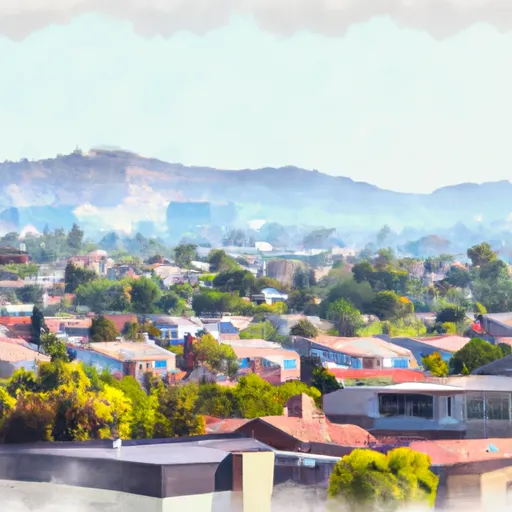-
 Snoflo Premium
Snoflo Premium
Get unlimited access to all our content
With no Ad interruptions! - Start Your Free Trial Login with existing account
Ladera
Eden Index
Climate
8.3
•
Recreation
5.4
•
Community
6.3
•
Safeguard
6.7/10

Ladera, California is a small unincorporated community located in San Mateo County, nestled in the hills between Portola Valley and Woodside. With its beautiful natural surroundings, Ladera offers a pleasant climate characterized by mild temperatures and abundant sunshine. Summers are warm and dry, while winters are cool and wet, making it an excellent place for outdoor activities year-round.
Ladera benefits from its proximity to the Santa Cruz Mountains, which provide a diverse hydrology system. The area is dotted with creeks and streams that flow into nearby reservoirs, ensuring a constant water supply for the community and supporting a rich ecosystem.
Outdoor enthusiasts in Ladera have a range of recreational opportunities to explore. The nearby Windy Hill Open Space Preserve offers hiking and horseback riding trails that provide breathtaking views of the surrounding landscapes. For those seeking water-based activities, nearby lakes and reservoirs provide opportunities for fishing, boating, and paddleboarding. Additionally, the community's location is ideal for cycling, with scenic routes winding through the hills and valleys.
Overall, Ladera, California offers a welcoming climate, diverse hydrology constituents, and a variety of outdoor recreation opportunities, making it an attractive destination for nature lovers and outdoor enthusiasts alike.
What is the Eden Index?
The Snoflo Eden Index serves as a comprehensive rating system for regions, evaluating their desirability through a holistic assessment of climate health, outdoor recreation opportunities, and natural disaster risk, acknowledging the profound impact of these factors on livability and well-being.
Climate Health Indicator (CHI): 8.3
Ladera receives approximately
976mm of rain per year,
with humidity levels near 87%
and air temperatures averaging around
15°C.
Ladera has a plant hardyness factor of
9, meaning
plants and agriculture in this region tend to thrive here all year round.
By considering the ideal temperature range, reliable water supplies, clean air, and stable seasonal rain or snowpacks, the Climate Health Indicator (CHI) underscores the significance of a healthy climate as the foundation for quality living.
A healthy climate is paramount for ensuring a high quality of life and livability in a region, fostering both physical well-being and environmental harmony. This can be characterized by ideal temperatures, reliable access to water supplies, clean air, and consistent seasonal rain or snowpacks.
Weather Forecast
Streamflow Conditions
San Francisco Bay
Area Rivers
San Francisco Bay
Snowpack Depths
San Francisco Bay
Reservoir Storage Capacity
San Francisco Bay
Groundwater Levels
Recreational Opportunity Index (ROI): 5.4
The Recreational Opportunity Index (ROI) recognizes the value of outdoor recreational options, such as parks, hiking trails, camping sites, and fishing spots, while acknowledging that climate plays a pivotal role in ensuring the comfort and consistency of these experiences.
Access to outdoor recreational opportunities, encompassing activities such as parks, hiking, camping, and fishing, is crucial for overall well-being, and the climate plays a pivotal role in enabling and enhancing these experiences, ensuring that individuals can engage in nature-based activities comfortably and consistently.
Camping Areas
| Campground | Campsites | Reservations | Toilets | Showers | Elevation |
|---|---|---|---|---|---|
| San Mateo Memorial County Park | 156 | 193 ft | |||
| Sanborn - Skyline County Park | None | 1,278 ft | |||
| Santa Cruz Port District | 12 | 14 ft | |||
| Butano State Park | 39 | 181 ft | |||
| Big Basin Redwoods State Park | 102 | 1,005 ft | |||
| Anthony Chabot Regional Park | None | 858 ft | |||
| Henry Cowell Redwoods State Park | 113 | 658 ft | |||
| Portola Redwoods State Park | 53 | 504 ft |
Catastrophe Safeguard Index (CSI):
The Catastrophe Safeguard Index (CSI) recognizes that natural disaster risk, encompassing floods, fires, hurricanes, and tornadoes, can drastically affect safety and the overall appeal of an area.
The level of natural disaster risk in a region significantly affects safety and the overall livability, with climate change amplifying these risks by potentially increasing the frequency and intensity of events like floods, fires, hurricanes, and tornadoes, thereby posing substantial challenges to community resilience and well-being.
Community Resilience Indicator (CRI): 6.3
The Community Resilience Indicator (CRI) recognizes that education, healthcare, and socioeconomics are crucial to the well-being of a region. The CRI acknowledges the profound impact of these elements on residents' overall quality of life. By evaluating educational resources, healthcare accessibility, and economic inclusivity, the index captures the essential aspects that contribute to a thriving community, fostering resident satisfaction, equity, and social cohesion.

